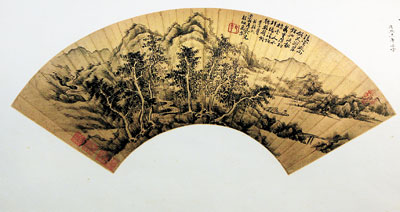
Cao Zhen
caozhen0806@126.com
EIGHTY-SEVEN paintings created by artists from Nanjing in the mid-17th century are on display at the Shenzhen Museum’s Civic Center outlet.
The paintings, mainly brushwork landscapes, flowers and birds, were created by artists of the Jinling style school, including the Eight Masters of Jinling (Gong Xian, Fan Qi, Ye Xin, Zou Zhe, Gao Cen, Hu Zao, Wu Hong and Xie Sun).
Jinling was a former name of Nanjing in East China’s Jiangsu Province. According to Guo Xuelei, vice curator of the Shenzhen Museum, Nanjing had been the capital of many dynasties, so the city had been well cultivated and developed into one of the commercial, cultural and political centers of ancient China.
“Nanjing was the international hub of East Asia and one of the largest cities in the world in ancient times. During the Ming Dynasty (1368-1644), the urban economy of Nanjing flourished, and industry and commerce developed rapidly. The beautiful landscape of eastern China helped turn out an endless series of master artists and made Jinling a center of art. The number of top-class artists, art collectors and dealers in the city and its neighboring areas, such as Suzhou, kept increasing. Important style schools on the Chinese art scene either hailed from or had close connections with Jiangsu,” said Guo.
The Eight Masters of Jinling were leaders of the Jinling style school. They demonstrated an elegant style using both sharp and flowing brush strokes. The most prominent of them was Gong Xian, who is known particularly for his dense, moist landscapes. Mountains and willows were prominent subjects. Other masters painted landscapes, flowers and human figures while Hu Zao specialized in sketching chrysanthemums and Wu Hong specialized in painting ink bamboo works.
Exhibits of Shi Tao, their contemporary who lived in Yangzhou, also deserve admiration. His brushwork is lively and relaxed, and his creativity influenced many modern artists such as Huang Binhong and Li Keran.
Wang Xiaochun, a researcher at the Shenzhen Museum, noted that during the late Ming and early Qing (1644-1911) dynasties in the mid-17th century, Nanjing also saw eight great female painters who were all courtesans; however, none of their works are on display during this exhibition. The courtesans expressed their feelings in their works, but few of their paintings survived due to their social status. Called “Eight Beauties of Qinhuai,” the courtesans were legendary beauties living in luxury brothels along the Qinhuai River in Jinling. These eight women, Liu Rushi, Gu Hengbo, Ma Xianglan, Chen Yuanyuan, Kou Baimen, Bian Yujing, Li Xiangjun and Dong Xiaowan, were accomplished poets and painters. Most of them experienced dynastic upheavals and the vicissitudes of life.
Dates: Until March 1
Hours: 10 a.m.-6 p.m. Closed Mondays
Venue: Shenzhen Museum, Block A, Civic Center, Futian District (福田区市民中心A区深圳博物馆新馆)
Metro: Shekou or Longhua Line, Civic Center Station (市民中心站), Exit B
|

